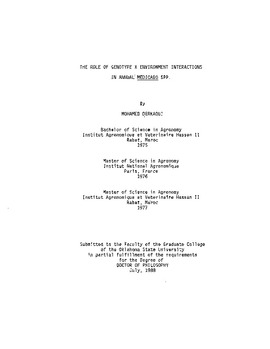| dc.contributor.advisor | Caddel, J. L. | |
| dc.contributor.author | Derkaoui, Mohamed | |
| dc.date.accessioned | 2015-11-09T22:22:46Z | |
| dc.date.available | 2015-11-09T22:22:46Z | |
| dc.date.issued | 1988-07 | |
| dc.identifier.uri | https://hdl.handle.net/11244/21198 | |
| dc.description.abstract | Scope of Study: Annual medics (Medicago spp.) are selfseeded cool season legumes. Originating from the Mediterranean basin, they present wide ranges of genetic material and adaptation. The potential of these pasture species for forage, seed production, and reseeding was investigated under the U.S. Southern Great Plains continental climate and in the medics' native habitat, Morocco. Eleven species of medics (23 accessions), two perennial alfalfas (M. sativa L.), and four clovers (Trifolium spp.) were included in the tests. The importance of genotype X environment (G X E) interactions in these species was evaluated under clean-tilled field conditions with a wide spectrum of environments. Biomass partitioning and root development were examined in these forage crops. | |
| dc.description.abstract | Findings and Conclusions: In the Southern Great Plains, forage and seed production of medics should come from spring planting (even though better establishment was obtained with fall plantings) until higher tolerance to cold than that found in the genotypes evaluated is developed. Production parameters were significantly influenced by genetic makeup and G X E interactions. Spring sown medics in Oklahoma or fall sown medics in Morocco produced forage yields equal to or higher than alfalfa and clovers. Forage of these species was good quality (high crude protein and low neutral and acid detergent fiber concentrations) at flowering. Establishment success positively influenced forage yield from spring plantings in Oklahoma. Certain species, e.g., M. scutellata, were able to produce an adequate soil seed-bank in Oklahoma, and demonstrated good forage and seed potential. However, the hard seed of these species did not germinate well in the subsequent growing season. All species were suitable for forage and commercial seed production in Morocco when rainfall was sufficient. Small-seeded species, e.g., M. truncatula, were better seed producers than large seeded ones. STgnificant associations existed between medic seed characteristics. Annual medics did not partition their biomass among plant organs similarly over time. However, they developed similar rooting systems. | |
| dc.format | application/pdf | |
| dc.language | en_US | |
| dc.rights | Copyright is held by the author who has granted the Oklahoma State University Library the non-exclusive right to share this material in its institutional repository. Contact Digital Library Services at lib-dls@okstate.edu or 405-744-9161 for the permission policy on the use, reproduction or distribution of this material. | |
| dc.title | Role of genotype X environment interactions in annual Medicago spp. | |
| dc.contributor.committeeMember | Horn, G. W. | |
| dc.contributor.committeeMember | Rommann, L. M. | |
| dc.contributor.committeeMember | Westerman, R. L. | |
| dc.contributor.committeeMember | Krenzer, E. G. | |
| osu.filename | Thesis-1988D-D433r.pdf | |
| osu.accesstype | Open Access | |
| dc.type.genre | Dissertation | |
| dc.type.material | Text | |
| thesis.degree.discipline | Agronomy | |
| thesis.degree.grantor | Oklahoma State University | |
